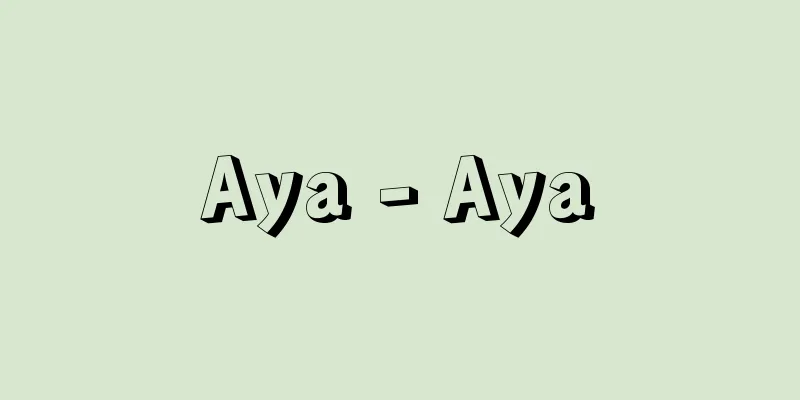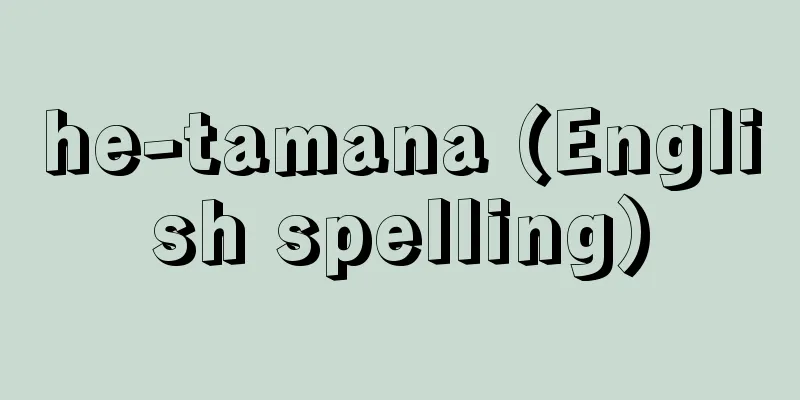Seven-word poem - Shichigonshi

|
A general term for classical Chinese poetry, each of which consists of seven characters. There are three types: the four-line seven-character quatrain, the eight-line seven-character regulated verse, and the seven-character ancient verse with an indefinite number of lines. While five-character poetry enjoyed its heyday from the Later Han to the Six Dynasties, seven-character poetry was long considered to be of a lower order, and did not begin to develop in earnest until the end of the Six Dynasties. However, its origins are actually older than that of five-character poetry. Since there are quite a few seven-character lines in the Chuci, some people believe that meaningless empty characters such as "kei" and "i" were gradually replaced by real characters and became seven-character poetry. However, the theory that it gradually came into the hands of literati based on the seven-character proverbs seen in the Warring States period seems more natural, since seven-character poetry had long been recognized as something of a lower order. Five-character poetry developed gradually with increasing sophistication, using the Yuefu (musician poems) as a medium, but seven-character poetry made a leap from experimental works such as Cao Zhi's "Yan Ge Xing," which imitates the "Bai Liang Tai Lien Qu" style of Emperor Wu of Han, and an anonymous author's "Bai Xuan Dancing Song," to Emperor Jianwen of Liang's "Crows Cry at Night." "Crows Cry at Night" already has an eight-line meter, but it seems that something close to this style suddenly appeared, piggybacking on the development of five-character poetry. Its development was remarkable in the Tang dynasty, passing through the Shen Xu period of the early Tang dynasty, Song Zhiwen, and Du Fu, when the rhyme style was perfected and the seven-character quatrain became the most important form of poetry. Meanwhile, in the field of ancient poetry, it developed into Li Bai's Kakou and Du Fu's Narrative, and after the height of the Tang dynasty, it surpassed the five-character quatrain. Because it allowed for a wider and more free expression than the five-character quatrain, it provided a world of activity for talented poets. [Tadahisa Ishikawa] Source: Shogakukan Encyclopedia Nipponica About Encyclopedia Nipponica Information | Legend |
|
1句が7字からなる中国古典詩の総称。4句で構成される七言絶句(ぜっく)、8句の七言律詩(りっし)、句数不定の七言古詩の三体がある。五言詩(ごごんし)が後漢(ごかん)から六朝(りくちょう)にかけて全盛を誇ったのに対し、七言詩は久しく低次のものとして扱われ、本格的な発達をみるのは、六朝も末期になってからであった。しかし、起源は五言よりもむしろ古い。『楚辞(そじ)』に七言の句がかなりみられることから、そのなかの「兮(けい)」や「矣(い)」などの無意義の虚字が、しだいに実字にかわって、七言詩となったとする説もあるが、戦国時代にみられる一句七言の俚諺(りげん)などが母体となって、しだいに文人の手に上ったとする説のほうが、七言詩が久しく低次のものとして認識されていただけに、自然に思われる。 五言詩は楽府(がふ)などを媒介としつつ、漸次洗練の度を加える発達を示したが、七言詩は、漢の武帝代の「柏梁台聯句(はくりょうだいれんく)」の手法を襲う曹植(そうしょく)の『燕歌行(えんかこう)』、無名氏の『白紵舞歌(はくちょぶか)』などの試作的なものから、梁(りょう)の簡文帝(かんぶんてい)の『烏夜啼(うやてい)』へと飛躍する。『烏夜啼』はすでに8句の律体をとっているが、五言詩の発達に便乗するかっこうで、このような近体に近いものがいきなり現れたものであろう。唐代に入ってその発達は目覚ましく、初唐の沈佺期(しんせんき)、宋之問(そうしもん)を経て、杜甫(とほ)に至って律体が完成し、七言絶句は詩のもっとも主要な形式となる。一方、古詩の分野でも、李白(りはく)の歌行(かこう)、杜甫の叙事と発展して、盛唐以後は五言をしのぐ勢いとなった。五言よりも広く自由な表現をとりうるだけに、力量を備えた詩人たちに活躍の世界を与えたのであった。 [石川忠久] 出典 小学館 日本大百科全書(ニッポニカ)日本大百科全書(ニッポニカ)について 情報 | 凡例 |
>>: Seven-five rhythm - Shichigocho
Recommend
Henry Bernard
Born January 24, 1811 in Hartford, Connecticut Die...
Twachtman, JH
...In the second half of the 19th century, we saw...
Mr. Umino
A clan whose family name is Unno-sho in Shinano Pr...
Osman - Osman
…While serving as a senator and judge as an arist...
Wilkie, Sir David
Born November 18, 1785, Cults, Fife, Scotland [Die...
Taga Taisha Shrine
Located in Taga Town, Inukami County, Shiga Prefe...
Centropus senegalensis (English spelling) Centropussenegalensis
…[Higuchi Hiroyoshi]. … *Some of the terminology ...
Sternoptychiidae
…They are also often found in the stomachs of bon...
Sparrow Dance - Sparrowbird
In the Edo period Elegance Free In the dance, they...
Management stock - Management stock
…However, in reality, only a very limited number ...
Onyo Onsen - Onyo Onsen
This hot spring is located in the west of Cheonan ...
Anima
〘Noun〙 (anima)① A Christian term. Soul. Spirit. ※D...
Kuniyaki - Kuniyaki
A general term for Japanese tea ware fired in kiln...
Field ion microscope - DENKAIONKENBIKYO
FIM is an abbreviation of FIM. It was invented by...
Arauco War - Arauco War
...They also knew about wooden houses, pottery, a...









